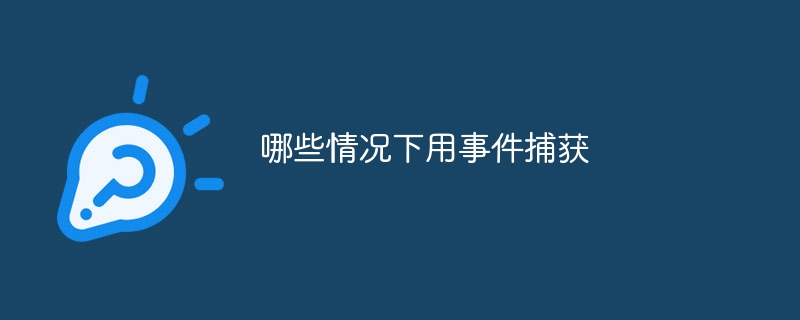
Use of event capture includes situations where the target element position is not fixed, events need to be preprocessed in advance, custom event delegation, processing asynchronously loaded elements, etc. Detailed introduction: 1. The position of the target element is not fixed. When the position of the target element is not fixed, the event cannot be processed through event bubbling, because event bubbling is transmitted upward from the target element. If the position of the target element is not fixed, Then the event handler cannot be triggered accurately; 2. The event needs to be preprocessed in advance. Sometimes it is necessary to perform some preprocessing operations before the event is passed to the target element, etc.

The operating system for this tutorial: Windows 10 system, DELL G3 computer.
In JavaScript, the event model includes two processing methods: event capture and event bubbling. Event capture means starting from the outermost element and passing the event down layer by layer until the target element is found; while event bubbling starts from the target element and passes the event upward layer by layer until it reaches the outermost element. Both treatments have their uses and are suitable for different situations. Here are some situations where event capture is used:
The position of the target element is not fixed: When the position of the target element is not fixed, the event cannot be processed through event bubbling. Because the event bubbles up from the target element, the event handler cannot be accurately triggered if the target element's position is not fixed. At this time, event capture can be used to pass events down layer by layer starting from the outermost element to ensure that the target element can be triggered correctly.
Need to preprocess events in advance: Sometimes it is necessary to perform some preprocessing operations before the event is delivered to the target element, such as validating user input, obtaining contextual information, etc. Use event capture to handle events before they are delivered to the target element, and then pass the event to the target element. This allows events to be processed in advance and improves the efficiency and robustness of the code.
Custom event delegation: In some cases, it may be necessary to use custom event delegation to achieve specific functions. Event delegation works by binding an event handler to the parent element, and then using the event handler to determine whether the event was triggered by the target element. Using event capture, you can first perform some necessary judgment and processing in the event handler, such as judging whether the event is triggered by a specified sub-element, and then pass the event to the target element. This allows for more flexible event handling.
Handling asynchronously loaded elements: When the elements in the page are loaded asynchronously, the target element may not be loaded until the page is loaded. At this time, if event bubbling is used to handle the event, the event handler of the target element may not be triggered. Using event capture can pass events down layer by layer after the page is loaded, ensuring that the target element can be triggered correctly.
It should be noted that there are also some disadvantages and limitations in using event capture. For example, certain situations may cause event handlers to be executed in the incorrect order, or to behave unexpectedly. Therefore, careful consideration and adequate testing and verification are required when using event capture. In addition, not all browsers support event capture, especially some old browsers or specific versions of browsers may not support it. Therefore, when using event capture, you need to consider browser compatibility and perform appropriate compatibility processing.
The above is the detailed content of When to use event capture. For more information, please follow other related articles on the PHP Chinese website!
 What are the production methods of html5 animation production?
What are the production methods of html5 animation production?
 Three major characteristics of java
Three major characteristics of java
 jdk environment variable configuration
jdk environment variable configuration
 mstsc remote connection failed
mstsc remote connection failed
 What are the common management systems?
What are the common management systems?
 Solution to invalid signature
Solution to invalid signature
 What are the definitions of arrays?
What are the definitions of arrays?
 How to enter root privileges in linux
How to enter root privileges in linux




